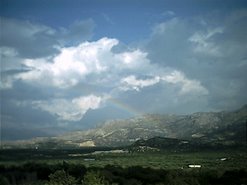Kikaigashima (Shunken in Noh).It's the whole play, in youtube
Summary
The time is the late Heian era when the Heike clan was at the height of its prosperity. The Buddhist priest Shunkan, who was ranked at Sōzu* and served as Shigyō (or Shugyō) Administrator** of the prestigious Hosshoji Temple in Kyoto, plotted to bring down the ruling Heike clan and was arrested. He is exiled to Kikaigashima Island in Satsumagata (the sea off southern Kyushu) with his fellow conspirators: Fujiwara no Naritsune and Taira no Yasuyori. Time passes, and a contingent general amnesty is declared in the capital to pray for the safe birth of a child of Taira no Tokuko (or Tokushi, Noriko), Consort of Emperor Takakura and a daughter of Taira no Kiyomori. Since a portion of the exiles in Kikaigashima Island is granted a pardon by the amnesty, an envoy is heading to the Island.

This piece was created for Noh performance based on the tragedy of the priest Shunkan told in the Tales of the Heike (Heike Monogatari). It is said that Kikaigashima Island, the place of exile is Iwojima Island, one of the three islands which are located west of Tanegashima Island and Yakushima Island in the southern ocean off present-day Kagoshima Prefecture. Although its name is the same as the island which became a battlefield during the Second World War, it is a different island; it is also called Satsuma-Iwojima Island. On the tiny island which is about 9 miles (15 km) around and 4.6 square miles (12 km²) in area, there is an active volcano, Mount Iwodake (2,322 feet, or 703 m), which even today is shrouded in its own fumes. Sulfur is exposed on the rocks and even the sea water around the island is dyed the color of sulfur. It is certainly an alien world, if we compare it with Kyoto where Shunkan once lived.
Summary
The time is the late Heian era when the Heike clan was at the height of its prosperity. The Buddhist priest Shunkan, who was ranked at Sōzu* and served as Shigyō (or Shugyō) Administrator** of the prestigious Hosshoji Temple in Kyoto, plotted to bring down the ruling Heike clan and was arrested. He is exiled to Kikaigashima Island in Satsumagata (the sea off southern Kyushu) with his fellow conspirators: Fujiwara no Naritsune and Taira no Yasuyori. Time passes, and a contingent general amnesty is declared in the capital to pray for the safe birth of a child of Taira no Tokuko (or Tokushi, Noriko), Consort of Emperor Takakura and a daughter of Taira no Kiyomori. Since a portion of the exiles in Kikaigashima Island is granted a pardon by the amnesty, an envoy is heading to the Island.
On Kikaigashima Island, pious Naritsune and Yasuyori
have selected places in the island as makeshift holy sites of the three
grand shrines of Kumano and make a pilgrimage there for prayer on a
regular basis. One day, Shunkan meets them on their return from a daily
shrine visit and offers a cup of valley water which he pretends is kiku no sake
(sake with chrysanthemum petals). They enjoy the party and miss Kyoto.
Then a messenger from Kiyomori arrives on the island with the good news.
However, there is no mention of Shunkan’s name in the letter of pardon.
Shocked, Shunkan sinks into the depths of despair while people around
him are unable to find words to consol him.
Soon the boat with Naritsune and Yasuyori on board
sails away from the island. Although Shunkan throws himself on his
fellow’s sleeve and begs to let him on board, he is mercilessly
abandoned and lies prostrate on the beach. As he cries hard without
caring anything, his fellows call out, “One day you will be able to
return to the capital. Pull yourself together!” But the voices grow
faint as the boat recedes into the distance and finally disappears from
view.
*Sōzu: One of the positions of Buddhist monks, which is ranked under Sōjō and above Risshi. He supervises monks and nuns.
**Shigyō (or Shugyō) Administrator: A monk who administers the office work of a temple.
**Shigyō (or Shugyō) Administrator: A monk who administers the office work of a temple.
This piece was created for Noh performance based on the tragedy of the priest Shunkan told in the Tales of the Heike (Heike Monogatari). It is said that Kikaigashima Island, the place of exile is Iwojima Island, one of the three islands which are located west of Tanegashima Island and Yakushima Island in the southern ocean off present-day Kagoshima Prefecture. Although its name is the same as the island which became a battlefield during the Second World War, it is a different island; it is also called Satsuma-Iwojima Island. On the tiny island which is about 9 miles (15 km) around and 4.6 square miles (12 km²) in area, there is an active volcano, Mount Iwodake (2,322 feet, or 703 m), which even today is shrouded in its own fumes. Sulfur is exposed on the rocks and even the sea water around the island is dyed the color of sulfur. It is certainly an alien world, if we compare it with Kyoto where Shunkan once lived.
On the island, Shunkan spent desperate days as an
exile with no hope for the future. However, probably because the
presence of two fellow conspirators consoled him, his state of mind –
missing Kyoto and exchanging cups of water that they pretend to be sake
– indicates a degree of leeway in his heart, even under such miserable
conditions. The envoy appeared. Filled with hope, Shunkan is grateful.
However, the brilliant hope disappeared in a moment. He learned that his
name alone was not mentioned in the letter of pardon, and he thoroughly
and repeatedly examined the letter, facing the inconceivable reality.
He who could not find his name shivers with anger and frustration.
Separated and left behind alone on the isolated island, he was pushed
into the abyss of even darker despair. Nothing would be comparable with
his pitiful situation.
This drama unemotionally but clearly describes his
despair in the movements of performers, which are not at all showy but
well-controlled, and in the finely-tuned chorus like deep ocean waves.
When we see and listen to this performance, we feel the underlying power
of expression in Noh art.
another summary
another summary
Shunkan
This work,
written by Chikamatsu Monzaemon, is based on part of the Heike monogatari
(tales of Heike [the Taira clan]).
Currently the only scene performed is the one about the warrior Shunkan and others who were exiled to Kikaigashima (Kikai island) for the crime of plotting a rebellion against the Taira Kiyomori, so this work is commonly called "Shunkan."
A shamensen (ship bearing pardons) has arrived from miyako (the capital) to take back 3 exiles: Shunkan, Tamba no Shosho Naritsune, and Heihangan Yasuyori. Shunkan, informed that his wife, left behind in miyako, has been killed, offers his place on the ship to the female diver, Chidori, who is married to Naritsune. This is forbidden by the messenger, Seno Taro. In despair, Shunkan kills Seno. For this crime, Shunkan must remain on the island. Shunkan, left alone on the island, watches the ship until it is out of sight.
Currently the only scene performed is the one about the warrior Shunkan and others who were exiled to Kikaigashima (Kikai island) for the crime of plotting a rebellion against the Taira Kiyomori, so this work is commonly called "Shunkan."
A shamensen (ship bearing pardons) has arrived from miyako (the capital) to take back 3 exiles: Shunkan, Tamba no Shosho Naritsune, and Heihangan Yasuyori. Shunkan, informed that his wife, left behind in miyako, has been killed, offers his place on the ship to the female diver, Chidori, who is married to Naritsune. This is forbidden by the messenger, Seno Taro. In despair, Shunkan kills Seno. For this crime, Shunkan must remain on the island. Shunkan, left alone on the island, watches the ship until it is out of sight.








No comments:
Post a Comment